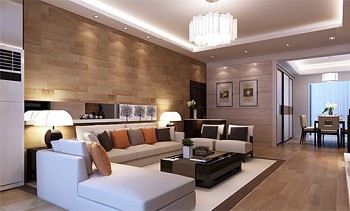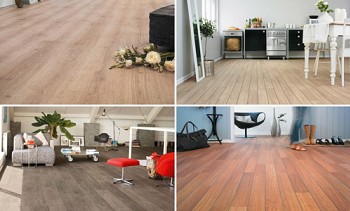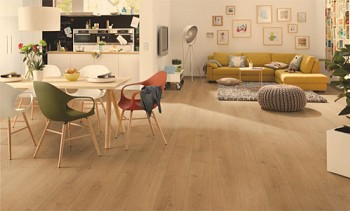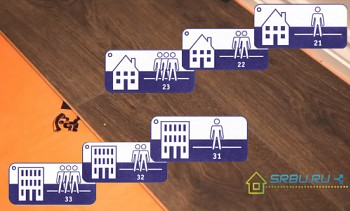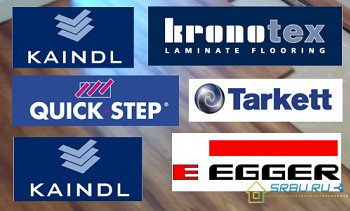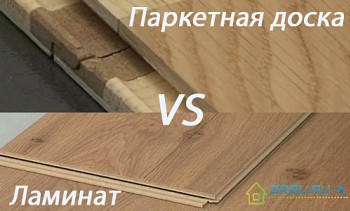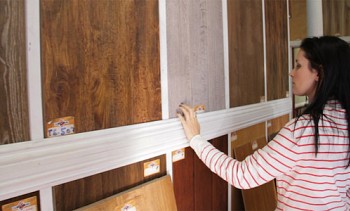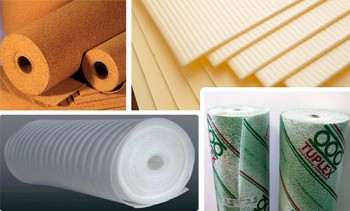For individual elements of a natural wood flooring, the angle formed by the front surface of the board and the side edge is often beveled. The chamfer allows you to make the cracks between the floorboards, which inevitably arise as a result of the drying of the wood, less noticeable.
Laminate is a largely synthetic material, so the problem of drying out here is not so acute, but sometimes a chamfer is applied to it. Its main purpose in this case is to make artificial flooring even more similar to natural. Tightly adjacent to each other, the lamellas are somewhat reminiscent of linoleum, they create a feeling of solidity, emphasize artificiality. Chamfers, visually separating the planks from each other, allow you to better simulate a plank coating.
How does the appearance of this decorative element affect the performance of the laminate flooring? Which laminate is better - with or without chamfer? The answers to these questions can be found only by analyzing the advantages and disadvantages of both types of coverage.
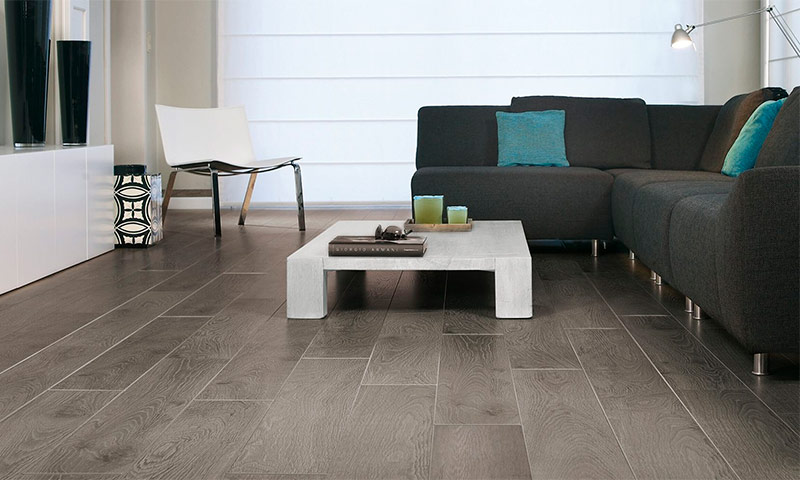
Content:
- What happens in a laminate
- How the chamfer affects the wear resistance of the laminate
- Which laminate is more moisture resistant - with or without chamfer
- What difficulties arise when cleaning a laminate with a chamfer
- Does the chamfer create difficulties when laying the laminate
- What flaws can be hidden by a chamfer, and how it affects the appearance of the floor
What happens in a laminate
The beveled edges of the laminate of different models may vary. This primarily concerns their shape and size.
The chamfer can be straight, made at an angle of 45 °, or curly, rounded. In the first case, when the two lamellae are joined, a V-shaped recess is formed, in the second - a U-shaped recess. The U-type gives the board a certain bulge, volume, but it is less common than the V-type.

Laminate with V shaped chamfer.

Laminate with a U-shaped chamfer.
According to the size of the formed recess, the chamfers are divided into small (1-2 mm or less) and deep (over 2 mm). The depth of the U-shaped grooves usually does not exceed 2 mm, for V-shaped recesses it can reach 4 mm. Microfaces are used to easily mark the edges of the lamella, while the deeper ones more clearly outline the boundaries. In addition, there are bevels with an increased width relative to the standard, which is achieved by increasing the cutting angle.
A chamfer can be applied both along the two long sides of the lamella and around its entire perimeter. Two-sided bevel boards visually lengthen the room, creating the effect of a ship’s wooden deck.

Each lamella with a four-sided chamfer is clearly delineated, which enhances the resemblance to a natural plank coating.

The chamfer may differ in application technology. If for products made of natural wood it is made by milling, then for a laminate a more acceptable method of rolling is squeezing the edges when rolling on a special machine. When rolling, the protective laminated coating is preserved, and the edge of the board is made denser than its middle, which is an indisputable advantage of this technology.
The reliability of a laminate with milled edges depends on the method of its final processing: the chamfer can simply be painted in the tone of the product (a cheaper finish) or laminated (a more expensive processing method, in which the protective layer that is damaged during milling is restored).
The type of chamfer has no practical value - the choice in this case should be made based solely on your aesthetic preferences. The main thing is that during its creation all production technologies are observed, and its surface is reliably protected.
How the chamfer affects the wear resistance of the laminate
In the area of the chamfer, the board is thinned, so we can expect that such a laminate will be more sensitive to stress.However, it should be borne in mind that a decorative edge cut is not done on panels thinner than 8 mm - usually these are products whose thickness is not less than 10-12 mm. The depth of the chamfer relative to the total thickness of such a board can be considered insignificant, which means that it should not have a special effect on the strength of the laminate.
Rolled chamfers have the greatest strength, since the pressed material acquires an increased density, however, the edges are treated in this way only with the expensive laminate produced by eminent companies. An ordinary edged edge that does not have a protective coating, but simply painted to match the color of the board, has reduced strength.
Tests conducted by manufacturers confirm that with a lamella thickness of 10 mm or more, the strength characteristics of the laminate with and without bevels coincide, with a smaller thickness, a conventional laminate is stronger.
A chamfer with sharp edges looks more impressive, but at the same time is subject to faster wear - its edges are instantly erased. If you have a choice, give preference to a laminate with a rounded chamfer.
Which laminate is more moisture resistant - with or without chamfer
Often, sellers of specialized stores and master finishers do not advise laying laminate in the kitchens and in other rooms where there is a high risk of spilling water on the floor. In this case, the argument, as a rule, is one: due to the presence of a chamfer, the contact area of the laminate with water increases. In fact, picking up a tape measure and calculator, you will quickly come to the conclusion that the chamfer increases the area by no more than 1-2%. Agree, not too much to start a conversation for this. However, there is some truth in the recommendations of specialists.
In fact, the problem is not so much in increasing the area of contact with water, but in the fact that the liquid spilled on the floor and not wiped in a timely manner on a flat flat surface forms a thin layer, which means that it evaporates much faster than from the recesses formed by chamfers , which will ultimately become the zone of the beginning of destructive processes. It follows from this that it is enough to observe a simple rule: do not pour water on the laminate, but if this happens, immediately wipe it off.
The moisture resistance of the laminate with a bevel is largely determined by the quality of the latter. If the beveled edge, like the entire front surface of the panel, is laminated and treated with a water-repellent, then it is not a weak point. However, such a high quality, as a rule, can boast only products of well-known brands manufactured in compliance with all technological regulations. In a cheap laminate (in most cases of Chinese manufacture), the chamfer is simply painted, and it does not have a protective coating. Of course, such a laminate will not differ in good water resistance and a long service life.

Laminate with no laminate.
Thus, if you have laid a high-quality laminate and you follow the rules set forth in the manual for the care of laminated surfaces, then with or without chamfer it does not play a special role.
What difficulties arise when cleaning a laminate with a chamfer
Most buyers who refuse to purchase a laminate with a chamfer and prefer the usual one, motivate this with their fears that the grooves between the planks will become clogged with garbage and dirt. Practice shows that these fears are in vain: the grooves formed during the laying of such a laminate are, in fact, not so great, dirt and dust do not accumulate there to a greater extent than on a smooth surface. And if the edges are treated with water- and dirt-repellent compounds, then the problem does look somewhat far-fetched.
The absence of any difficulties is confirmed by people who have experience in cleaning both types of floor coverings. In their opinion, sweeping a broom with a bevel is really more difficult.But when dry cleaning with a vacuum cleaner or wet cleaning with a mop with a good nozzle, they did not notice much difference between a laminate with a bevel and without.

The issue of chamfering mud can be relevant only in the most problematic areas - in the hallway and in the kitchen. To prevent this, you just need to regularly clean these rooms.
Does the chamfer create difficulties when laying the laminate
There is an opinion that it is easier to lay a laminate with a chamfer, because it supposedly perfectly conceals all errors and irregularities, which means that you can not really try to level the base of the floor. In fact, the requirements of the manufacturers for the base for laying the laminate with the appearance of a chamfer do not change - it should be hard, clean and dry, and irregularities should not exceed 2 mm per linear meter.
Of course, the chamfer will visually smooth out the height differences between adjacent boards, connected with the roughness of the rough floor, but it will not save you from the increased load on the locks. Failure to comply with the rules of installation will lead to the fact that the locks quickly loose and protruding along the height of the part of the boards prematurely erase.

In general, the technology of laying the laminate does not depend on whether it is chamfered or not. This decorative element does not create any additional difficulties during installation.
What flaws can be hidden by a chamfer, and how it affects the appearance of the floor
Why does a laminate need a chamfer, if it is insignificant, but worsens the performance of the floor covering? Exclusively as a decorative element. Firstly, and we already mentioned this, it gives the laminate a resemblance to natural floor coverings - piece parquet or massive floorboard. Secondly, a chamfered laminate will help to visually increase the room in which it is laid.
In addition, the beveled edge of the panel allows you to hide minor floor defects. True, in this regard, the possibilities of a laminate with a chamfer, as a rule, are somewhat exaggerated.
Micron gaps at the joints of panels, especially clearly visible on a light coating, the bevel is really able to mask. Over time, as the locking joints weaken during the operation of the laminate, the gaps will increase, standing out more and more. If their value does not exceed fractions of a millimeter, which are included in the tolerances for high-quality castle joints, then the chamfer will help to make this problem area inconspicuous, since it focuses on the isolation of each board. Thanks to this, your laminate will look like new for a long time.
However, it is foolish to hope that the chamfer will help get rid of the problems associated with laying the laminate on an unprepared base. Of course, it will slightly visually smooth the height differences at the neighboring slats, but it will not protect in any way from the increased load on the locks caused by roughness of the subfloor, and from the formation of cracks, which will appear sooner or later. Regardless of whether the laminate is chamfered or not, it is better not to rely on chance when laying it. Remember that the chamfer is designed to perform a decorative function, and not hide defects at all.

Thus, there are no significant differences in the operational characteristics of a laminate with a chamfer and without it. A chamfer is just a decorative element, therefore, when choosing one or another type of laminate, you need to be guided exclusively by your own preferences, as well as the style in which the interior is made. However, so that the result does not disappoint you, you should give preference to high-quality products from reputable manufacturers who do not save on chamfering.

